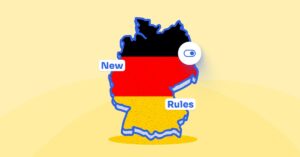Introduction
Shopify owners have a legal and ethical obligation to protect their users’ privacy and ensure compliance with privacy regulations. In this context, Google Consent Mode v2, which is based on the previous version v1, has emerged as a crucial tool that enables store owners to align with evolving privacy standards and best practices.
The implementation process of Google Consent Mode v2 involves integrating a code snippet into the store’s codebase, and then a cookie consent banner asks the user for their consent to allow or not cookies and other tracking technologies to fire. This banner can be customizable and can be designed to match the store’s branding and style. Note that the selected banner must support Google Consent Mode.
The benefits of Google Consent Mode v2 for store owners are numerous and significant. First and foremost, it helps them comply with privacy regulations such as the General Data Protection Regulation (EU GDPR) and the California Consumer Privacy Act (CCPA) by obtaining explicit and informed consent from users before collecting and processing their personal data. Additionally, it enables store owners to optimize their advertising campaigns by providing access to restricted data and insights that are only available with user consent.
What is Google Consent Mode
Google Consent Mode is an open API created by Google, enabling your store to operate all its Google services, including Google Analytics, Google Tag Manager, and Google Ads, according to your end-users’ consent status.
It regulates the functioning of all Google tags and scripts on your site in alignment with the user consent provided through your website’s consent management platform. This advanced solution addresses data privacy concerns by giving users control over their data collection for personalized advertising and audience measurement purposes.
Using Google Consent Mode v2 with the proper cookie banner ensures you receive vital consent insights and analytics through data modeling and non-identifying data. When Google Consent Mode v2 is activated, you are ready to collect and signal valid user consent for Google services such as Google Analytics 4, Google Ads, or gtag.
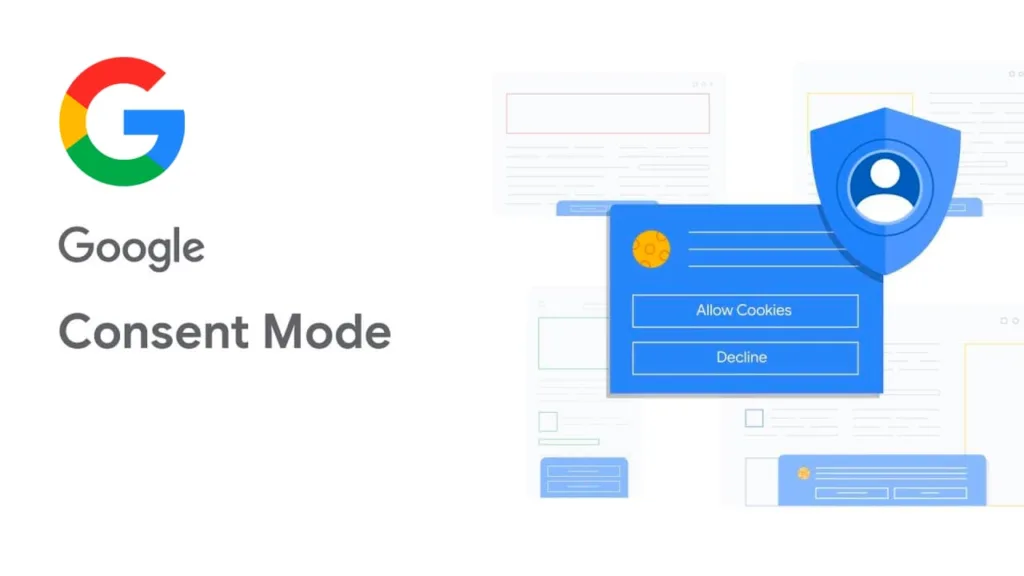
Key features of Google Consent Mode v2
Google Consent Mode v2 is a new and improved version of the previous consent mode that offers a range of enhancements and benefits to store owners and users alike. One of the most significant advantages of this new version is that it allows store owners to safeguard user privacy by collecting only necessary data, which ensures compliance with data protection regulations.
Moreover, Google Consent Mode v2 offers additional parameters that store owners can use to adjust Google tags based on user choices, providing a tailored experience while maintaining adherence to privacy standards.
This means that users will have more control over their data and can choose how much information they want to share with the website. Additionally, store owners can provide users with more customized experiences based on their preferences, improving the overall user experience.
To support collecting granular user consent, Google has updated the consent mode API to include two additional parameters, ad_user_data, and ad_personalization, as well as a revamped URL schema for passing consent states to Google’s services.
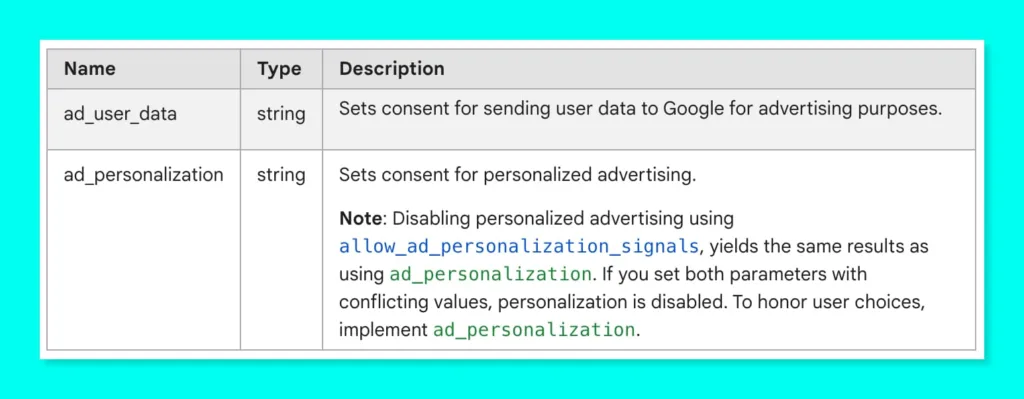
Addressing data privacy regulations
With the ever-increasing focus on data privacy and the introduction of regulations like the Digital Markets Act, store owners face complex challenges in navigating the evolving privacy landscape. To help store owners remain compliant with these regulations, Google has introduced Consent Mode v2.
This tool ensures store owners collect only necessary user data by relying on explicit consent. By using Consent Mode v2, store owners can easily and confidently navigate the complexities of data privacy regulations. This not only helps them avoid potential legal issues but also helps build trust with their users by respecting their privacy concerns.
First-party data and its role
Google Consent Mode v2 is an updated version of the Google Consent Mode that has been designed to prioritize first-party data in advertising. The new version enables store owners to make the most out of the user-provided explicit consent for optimizing the first-party data collection.
Through the collection of this data, store owners can enhance their understanding of their audience and create more effective advertising campaigns. This approach aims to provide store owners with more control over their data and to ensure that users are only shown personalized ads that are relevant to them.
Advanced Consent Mode vs. Basic Consent Mode
Google Consent Mode v2 introduces two distinct approaches to implementing consent mode: Basic and Advanced Mode. Understanding the differences between these modes is crucial for marketers navigating the intricacies of user consent and data privacy.
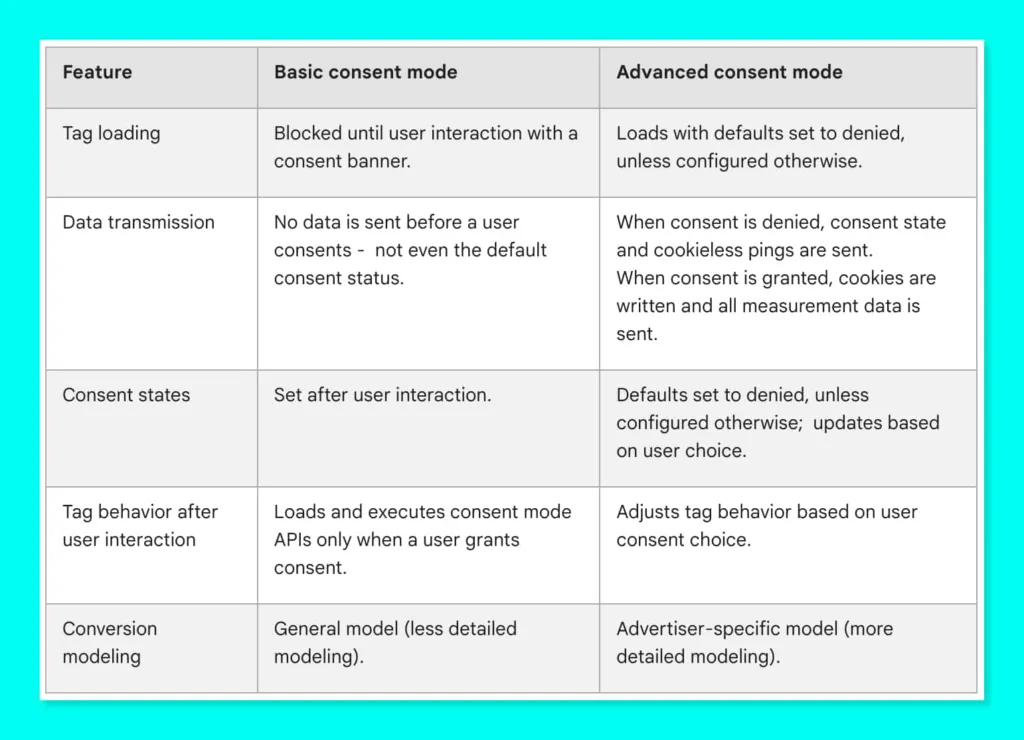
Basic Consent Mode
Google’s Consent Mode v2 offers a Basic Consent Mode that helps store owners comply with privacy regulations while collecting user data based on their explicit consent choices. This mode provides a streamlined approach that ensures data collection only happens when users have explicitly granted consent. The Basic Consent Mode is ideal for store owners who want a straightforward solution for their data collection needs while complying with privacy regulations.
This mode also allows for essential performance tracking, enabling store owners to keep track of their website’s performance without compromising user privacy. By implementing the Basic Consent Mode in Google Consent Mode v2, store owners can provide their users with a safe and secure experience while maintaining essential data collection and performance tracking.
Advanced Consent Mode
Obtaining user consent for data collection has become crucial to compliance with privacy regulations such as GDPR and CCPA. While the Basic Consent Mode is a widely used approach, it has limitations. This is where Advanced Mode comes in.
Unlike the Basic Consent Mode, which only allows data collection from users who explicitly grant consent, the Advanced Mode offers a more nuanced and flexible approach. With this functionality, marketers can collect data from users who do not grant explicit consent, thus enabling a more comprehensive data collection process.
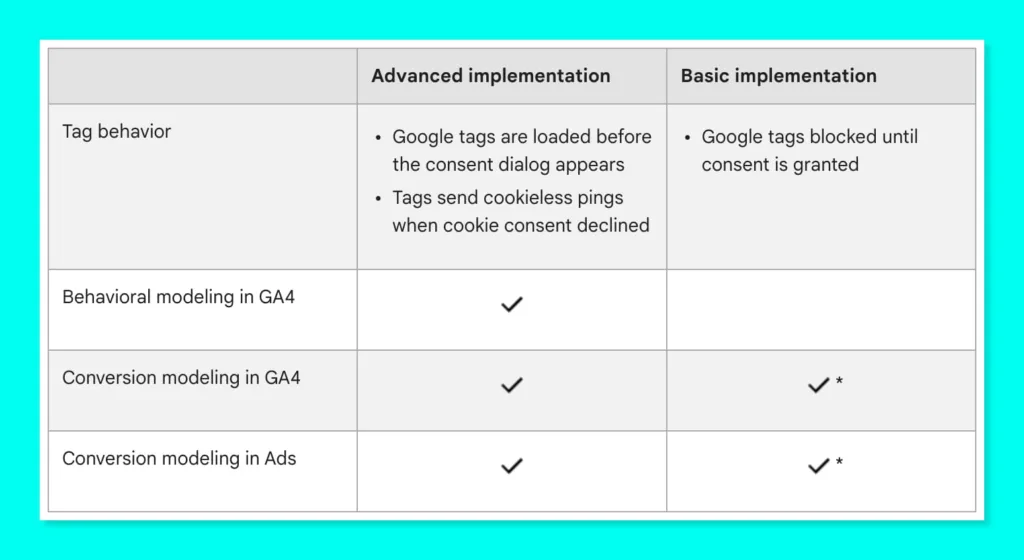
This advanced functionality is particularly beneficial for marketers who require granular insights into user behavior, even when some users decline consent. By providing more control over the data collection process, Advanced Consent Mode allows marketers to gain deeper insights into user behavior, which can be used to optimize marketing strategies and enhance user experiences.
Tradeoffs between Basic and Advanced Consent Modes
Regarding tracking user performance after they have rejected consent, two different modes of operation can be used: Basic Consent Mode and Advanced Consent Mode. While both modes have their own benefits, there are also tradeoffs to consider.
Basic Consent Mode is designed to ensure that user choices are strictly adhered to so that their personal data is not used without their explicit consent. This mode is ideal for businesses that want to maintain a high level of transparency and respect for user privacy. However, the downside of this approach is that it may limit the amount of data that is available for analysis since users who do not explicitly consent may not be included in the dataset.
On the other hand, Advanced Consent Mode sacrifices some user control to obtain additional insights from users who do not explicitly consent. This mode is more flexible since it allows businesses to use certain types of data even if the user has not explicitly consented to its use. This can be useful for businesses that want to gain a deeper understanding of user behavior and preferences. However, the downside of this approach is that it may not be as transparent or respectful of user privacy as the Basic Consent Mode.
Implementation considerations
When marketers are faced with the decision of choosing between Basic and Advanced Consent Modes, they must carefully evaluate their objectives and user engagement strategy. Basic Mode is particularly suitable for those prioritizing user control over data usage. This mode ensures that users clearly understand the data being collected and how it will be used.
On the other hand, Advanced Mode is more suitable when marketers need to obtain data from a broader audience. In such scenarios, the objective is to collect a large amount of data from users, and the focus is on obtaining consent from as many users as possible.
It is essential to note that both modes have advantages and disadvantages, and the choice between them depends on several factors, such as the type of data being collected, the target audience, and the marketing goals. By carefully considering these factors, marketers can choose the mode that best suits their needs and achieve their objectives while ensuring user privacy and consent.
Modeling in Google Ads
Google has briefly touched upon the topic of Consent Mode modeling without delving into the details. From the information provided, it appears that the Advanced Consent Mode comes with the added ability to model data, which can provide more precise insights into user behavior.
This is a feature that is not available in the Basic Consent Mode. With Advanced Consent Mode, businesses can use the modeled data to improve their advertising strategy and better understand their target audience. This modeling feature is designed to work while still maintaining user privacy, ensuring that all data collected complies with privacy regulations.
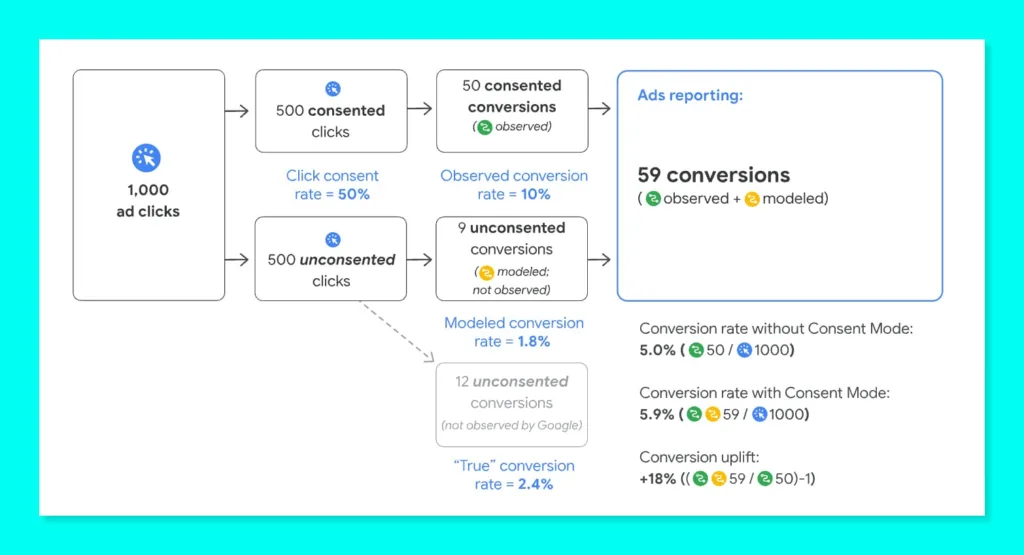
Modeled data and conversion modeling
Google Consent Mode v2 has now introduced more granular control, which offers store owners a more accurate way of modeling their data for conversion tracking. This means that store owners can now rely on modeled data to gain deeper insights into their users’ behavior without compromising their users’ privacy. This modeling includes Google Ads consent mode modeling, Google Ads online modeling, Google Analytics conversion modeling, and Google Analytics behavioral modeling.
With this new feature, store owners can rest assured that their tracking efforts are in line with privacy standards while still being able to obtain valuable information about their users. This is a significant step forward in data tracking and privacy, as it allows for both the collection of valuable insights and the protection of user privacy.
Challenges and solutions in implementing Consent Mode V2
While implementing Google Consent Mode v2, store owners encounter challenges such as user declines in consent and the risk of missing crucial data. Effective solutions are essential to address these issues. The implementation process can benefit from strategies such as clear communication through a well-designed consent banner. Educating users about the advantages of providing consent is equally crucial, as well as fostering transparency and trust.
Among the various consent management platforms available for Shopify stores, the Pandectes GDPR Compliance app stands out as an exemplary solution. Pandectes offers a comprehensive approach to GDPR compliance, providing store owners with the tools they need to navigate the complexities of user consent. By leveraging Pandectes, store owners can enhance their implementation of Google Consent Mode v2 and ensure a user-friendly and legally compliant online environment. There are many available consent management platforms on the market. Still, Shopify has very specific requirements that Pandectes has implemented, and no coding is required to make your store compliant with GDPR and Google services. Finally, it helps store owners manage user consent.
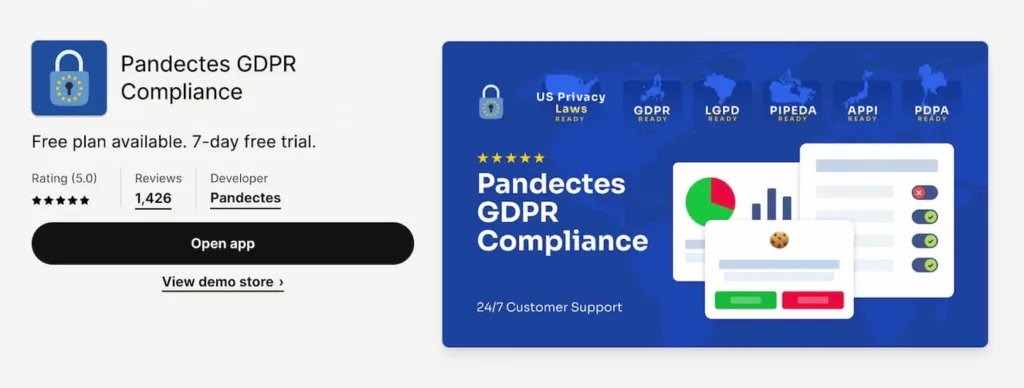
Implications for ad personalization
With the implementation of Google Consent Mode v2, advertisers now have a better opportunity to personalize ads while respecting user privacy. The update offers more precise and user-approved data that advertisers can use to enhance the effectiveness of their ad campaigns. This means that users will only see ads that are relevant to their interests and preferences while maintaining their privacy.
The new update also ensures that advertisers have more trust in the data they are using, leading to better decisions and more effective campaigns. Overall, the Google Consent Mode V2 has positive implications for both advertisers and users and is a step towards a more privacy-focused digital advertising ecosystem.
Conversion tracking and measurement solutions
Google Consent Mode v2 is a powerful tool that enables website owners to accurately track and measure user behavior without infringing on their privacy. It works by obtaining explicit user consent to collect data, which is then used to generate reliable insights into user behavior.
This consent-based approach ensures that website owners have access to accurate data, which is crucial for making informed decisions and improving user experience. With Google Consent Mode v2, website owners can rest assured that they collect user data responsibly and ethically and respect their privacy.
Conclusion
To maintain compliance with data privacy regulations and ensure user transparency, website owners should prioritize updating their privacy strategy with Google Consent Mode v2 compliance. It is important to note that this update must be completed before March 2024 to avoid any potential penalties or legal issues. By implementing Google Consent Mode v2, website owners can enhance user trust and improve the effectiveness of their advertising efforts.
This updated privacy strategy gives users more control over their data and provides more transparency regarding using their personal information. Overall, prioritizing Google Consent Mode V2 compliance is a crucial step for website owners to take to maintain compliance with data privacy regulations and improve user trust and transparency.


